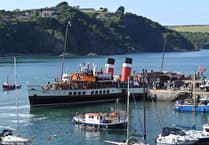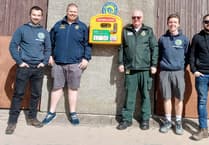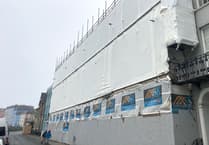Lying some three miles along the coast to the north of historic Tenby is the popular resort of Saundersfoot, a much newer settlement than its near neighbour.
Saundersfoot began life as a small fishing village, but it was the discovery of 'black gold', the highest quality anthracite found in the world at that time, that put the village firmly on the map.
Mining became a way of life, as it did throughout the Principality, as coal was exported throughout the world. Saundersfoot's own harbour was built in 1829, with rail links to six local collieries bringing load after load down to the quayside to be loaded onto small coasters.
Such was the magnitude of the operation, that by 1845 some 20,000 tons a year was exported from just one colliery.
It was not until some time later that two ironworks were founded at Wisemans Bridge, using iron ore discovered in the cliffs between Saundersfoot and Amroth. Wisemans Bridge can be reached through the tunnels to the east of Saundersfoot, created to facilitate this operation.
The main street running adjacent to Saundersfoot's main beach, 'The Strand', formerly went by the rather more industrial name of 'Railway Street', and its very name gives away the fact that it is along there that trains trundled, laden with coal to be loaded from the harbour.
Indeed, what is now the Information Centre (situated on the village's main car park) was formerly the colliery offices, one of the few remaining links with the village's heavy industrial past.
However, as the turn of the century approached, the coal and iron ore seams became thinner and more sporadic and unable to match the growing South Wales coalfield. By the outbreak of the Second World War, the two existing major pits had closed and tourism, which had been on the increase since the early 1900s, took root as the village's key industry.
During the 1800s, shipbuilding played an important part in the local economy, with two yards - Beddoes and Reids - being established in what was then called Railway Street. The yards relied heavily on timbers felled in local woods and seasoned on site, both yards specialising in the building and repairing of small coaster vessels of up to a few hundred tons.
For the uninitiated visitor, signs of any past industrial activity in the village are hard to come by, as the trappings of the modern tourist industry have taken a firm grip.
Saundersfoot is now a lively resort packed with a variety of shops, craft and pottery studios, pubs, restaurants and cafes, plus a wide array of accommodation to make it the ideal holiday centre to explore both South Pembrokeshire and further afield.
During the lazy summer days, the harbour is a hive of activity, as pleasure cruises, fishing trips, parascending, water-skiing, windsurfing, and much more presents a range of activities to suit any holidaymaker.
The village has a well established and busy sailing club based on the harbour which stages many events throughout the summer season, including regattas which see the area just off shore from the main beach become a blaze of colour.
As a family holiday destination, Saundersfoot has several appealing aspects, including the resort's three sandy beaches, which provide a safe environment for swimming and many other maritime activities.
To the east of the long, flat main beach lies Coppet Hall, an attractive beach with its own car park and associated services.
To the south-west (behind the picturesque harbour) lies the Glen Beach and a number of secluded inlets leading around to Monkstone Point.
Above the widely renowned beaches you can tread some of the most spectacular coastal footpaths in the country, with the village being within the Pembrokeshire Coast National Park (Britain's only coastal National Park).
The cliff path linking Tenby and Saundersfoot may well be for the energetic, but comes highly recommended for its views of both resorts and the coves and inlets such as Waterwynch and Monkstone.
Set in a wooded valley on the outskirts of Saundersfoot is the parish church of St. Issell's, which is a must for all visitors and is easily accessible along the footpath through the Coppet Hall Meadow, just a stone's throw from the beach of the same name.
Saundersfoot has several car parks in the centre of the village and a sizeable coach park on its outskirts. The Tourist Information Centre can be found on the harbour car park and it is there that you, the visitor, can find more about this intriguing little village.



